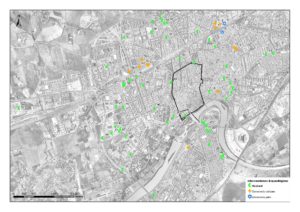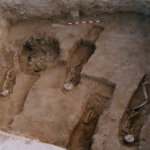
The death

The written sources document up to a total of 21 cemeteries in Qurtuba, largely located by the archaeological interventions carried out in the last twenty years. They were large areas arranged outside the walls that came to hold thousands of tombs on the surface. Often several overlapping levels of burials have also been recorded, especially in the oldest ones: as the cemetery or Maqbarat of Arrabal, in the south of the river, or the Umm Salama, in the current Colón Park, north of the Medina.

The Muslim rite disposed the corpse in a simple pit excavated in the ground and without a coffin, wrapped only in a shroud and in a right lateral decubitus position, with the lower extremities slightly flexed, the arms gathered over the pubic region and the face oriented towards the Mecca, in southeast direction. Generally no trousseau was found, but occasionally certain elements of personal adornment such as rings, earrings and candles may be found, related to the prayers performed during the seven nights after the funeral of the deceased.

The tomb was covered with tiles arranged transversely and topped with small soil mounds. Sometimes they could have gravestones or factory structures that allowed a better delimitation and location. Exceptionally, the tombs of important religious figures could stand out with a small construction of quadrangular design or qubba that could be located also intramuros, like the rawda or funerary garden of the emirs and Umayyad caliphs, protected to the interior of the Alcazar.
There were also specific cemeteries for Christians and Jews, such as those discovered in the surroundings of Cercadilla, northwest of the Medina, and in the Zumbacon, northeast of the Axerquia.
Bibliography
CASAL GARCÍA, M.T. (2001): “Los cementerios islámicos de Qurtuba”, Anales de Arqueología Cordobesa, 12, pp. 283-313.
CASAL GARCÍA, M.T. (2003a): Los cementerios musulmanes de Qurṭuba. Monografías de Arqueología Cordobesa, 9. Córdoba.
CASAL GARCÍA, M.T. (2003b): “Aspectos morfológicos de los cementerios musulmanes de Qurṭuba”, en Andalucía medieval. Actas del III Congreso de Historia de Andalucía, Córdoba, 2001, vol. 5, pp. 305-318.
CASAL, M.T., VALDIVIESO, A.; LEÓN, A.; SORIANO, P.; LÓPEZ, R.(2006): “Espacio y usos funerarios en la Qurṭuba islámica”, Anales de Arqueología Cordobesa, 17, vol. II, pp. 257-290.
CASTEJÓN, R. (1965): “Excavaciones en Córdoba para localizar las tumbas de los califas”, N.A.H., 7, pp. 229-235.
LEÓN MUÑOZ, A. (2008-2009): ““¡Hombres! La promesa de Dios es verdadera”… El mundo funerario islámico en Córdoba (siglos VIII-XIII)”, Arqueologia Medieval, 4-5, pp. 24-49.
LEÓN MUÑOZ, A.; CASAL GARCÍA, M.T. (2010): “Los cementerios de Madīnat Qurṭuba”, en VAQUERIZO GIL, Desiderio; MURILLO REDONDO, Juan Francisco: El anfiteatro romano de Córdoba y su entorno urbano. Análisis arqueológico (ss. I-XIII), vol. 2, pp. 651-684.
MONTEJO CÓRDOBA, A. (2006): “La Rauda del Alcázar de Córdoba”, Anales de Arqueología Cordobesa, 17, vol. 2, pp. 237-256.
PINILLA MELGUIZO, R. (1997): “Aportaciones al estudio de la topografía de Córdoba islámica: almacabras”, Qurtuba, 2, pp. 175-214.

